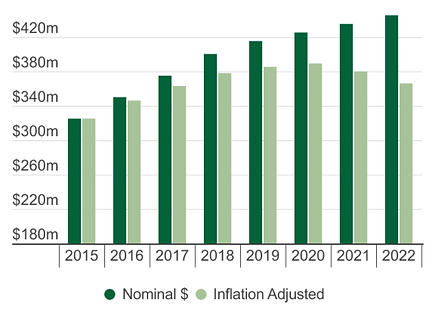OUR TOP PRIORITY
ENSURE AMPLE FUNDING FOR WORLD-CLASS INNOVATION
Agricultural research drives solutions that protect our food, fuel, and fiber supply; strengthen the economy; and keep U.S. producers competitive worldwide.
At agInnovation, our priorities are clear: sustain the foundation, fuel innovation, and respond rapidly to the challenges that shape our future.
agInnovation leverages Hatch Act and AFRI (Agriculture and Food Research Initiative) funding to ensure:
Global Competitiveness
Equipping US producers to lead on the world stage
National Security
Safeguarding America’s food, fuel, and fiber supply
Economic Impact
Powering a $4T sector and supporting 15% of U.S. jobs, delivering 20-to-1 return on investment
Public Good
Delivering unbiased research in areas the private sector overlooks

$4T
agriculture’s contribution to the U.S. economy

15%
of U.S. jobs supported by agriculture and food sectors

20:1
ROI on agricultural research investment

50
States + Territories served by Agricultural Experiment Stations
(agInnovation)
Impact a Glance
Consquences of Flat Funding
Capacity funding is the bedrock of innovation that secures America’s long-term food supply, environmental sustainability, nutritional security, and economic growth.
As a foundation of U.S. national security and global competitiveness, Hatch Act funding fuels efficient, science-based solutions that provide stable support for rapid response and sustain the expertise, infrastructure, and equipment needed to tackle challenges year-round.
Like competitive grants, these funds follow merit-based criteria but are guided by state priorities and stakeholder input, ensuring investments that are both targeted and responsive.
Publicly funded research through capacity programs also addresses high-risk, high-impact areas that private firms often overlook—delivering broad social benefits and advancing the public good.
Eroding Research, Education and Extension Capacity
Weakening food security, nutrition and health, workforce , and the U.S. economy.

Shrinking the domestic scientific workforce
Fewer scientists to support U.S. agriculture, food sectors, and communities

Outsourcing Innovation to Other Countries
Shifting research abroad and privatizing knowledge and falling behind nations investing in public agricultural research and development

Driving higher food prices & deepening supply chain vulnerabilities
Fragile food supply chains will buckle under increased presure and food prices will rise, access will be reduced, and hunger will become more prevelant

A $1,000,000,000 Request for Support
The Agriculture and Food Research Initiative (AFRI), administered by USDA’s National Institute of Food and Agriculture (NIFA), is the nation’s leading competitive grants program for agricultural science.
Established in the 2008 Farm Bill and reauthorized at $700 million annually, AFRI supports research, education, and extension projects that strengthen rural economies, enhance food production and safety, improve human health and nutrition, protect natural resources, and build the agricultural workforce of the future. Funded at $445.2 million in 2024, AFRI advances innovation across six priority areas—from plant and animal health to bioenergy, technology, and rural development—helping the U.S. meet growing global food and resource demands while safeguarding national security and sustainability.

Strengthening Foundational Research: Hatch Act
$300M requested
For nearly 140 years, Hatch Act funding has been the backbone of agricultural innovation, providing stable, long-term support to Agricultural Experiment Stations (AES) in every state and territory.
These funds:
-
Secure U.S. food, fuel, and fiber supply – ensuring national security and resilience.
-
Deliver global competitiveness – equipping U.S. producers to lead on the world stage.
-
Power economic impact – sustaining a $4T sector and 15% of American jobs with a 20:1 return on investment.
-
Enable crisis response – funding science-informed solutions to disease outbreaks, extreme weather, invasive species, and other urgent challenges.
-
Drive public good – supporting high-risk, high-impact research areas the private sector cannot address.
Without sustained Hatch funding, America risks outsourcing innovation abroad, shrinking its scientific workforce, and facing higher food prices and supply chain disruptions.

Driving Innovation Through Competitive Research: AFRI
$700M requested
The Agriculture and Food Research Initiative (AFRI), established in the 2008 Farm Bill, is the nation’s premier competitive grants program for agricultural sciences. At full authorization of $700M, AFRI fuels discovery by:
-
Tackling critical food and environmental challenges through integrated research, Extension, and education.
-
Strengthening the agricultural workforce by training the next generation of scientists, producers, and innovators.
-
Leveraging public-private partnerships to accelerate discovery and adoption.
-
Ensuring national resilience by building on capacity-funded infrastructure and knowledge to secure a safe, nutritious, and sustainable food supply.
Flat funding erodes this capacity, weakens U.S. competitiveness, and risks privatizing innovation abroad. AFRI investments safeguard the future of American agriculture and its role in ensuring global food security.

CALL TO ACT NOW
Together, Hatch and AFRI funding form the foundation and the future of American agricultural innovation.
Capacity funds under the Hatch Act sustain the expertise, infrastructure, and stability that keep U.S. agriculture strong year-round—delivering science-based solutions, rapid crisis response, and research guided by the needs of farmers, ranchers, and communities. AFRI builds on this foundation, driving discovery through competitive research, education, and Extension that strengthen our food system, workforce, and environment.
Flat or declining funding threatens to erode America’s research strength, outsource innovation, shrink our scientific workforce, and weaken national competitiveness. To safeguard U.S. food security, nutrition, and economic resilience, Congress must fully fund Hatch at $300 million and AFRI at $700 million—investments that deliver a twenty-to-one return, protect national security, and ensure America continues to lead the world in agricultural science and innovation.
Now is the time to act—be bold, invest in the future, and secure U.S. agriculture for generations to come.

